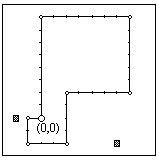Not an official ACM page
[Problem E
| 1993 ACM finals problem set
| My ACM problem archive
| my home page]
1993 ACM Scholastic Programming Contest Finals
sponsored by AT&T EasyLink Services
Problem D
Golygons
Imagine a country whose cities have all their streets laid out in a
regular grid. Now suppose that a tourist with an obsession for
geometry is planning expeditions to several such cities. Starting each
expedition from the central cross-roads of a city, the intersection
labeled (0,0), our mathematical visitor wants to set off north,
south, east or west, travel one block, and view the sights at the
intersection (0,1) after going north, (0,-1) after going south, (1,0)
after going east or (-1,0) after going west. Feeling ever more
enthused by the regularity of the city, our mathematician would like
to walk a longer segment before stopping next, going two
blocks. What's more, our visitor doesn't want to carry on in the same
direction as before, nor wishes to double back, so will make a 90 turn
either left or right. The next segment should be three blocks, again
followed by a right-angle turn, then four, five, and so on with
ever-increasing lengths until finally, at the end of the day, our
weary traveler returns to the starting point, (0,0).
The possibly self-intersecting figure described by these geometrical
travels is called a golygon.
Unfortunately, our traveler will making these visits in the height of
summer when road works will disrupt the stark regularity of the
cities' grids. At some intersections there will be impassable
obstructions. Luckily, however, the country's limited budget means
there will never be more than 50 road works blocking the streets of
any particular city. In an attempt to gain accountability to its
citizens, the city publishes the plans of road works in advance. Our
mathematician has obtained a copy of these plans and will ensure that
no golygonal trips get mired in molten tar.
Write a program that constructs all possible golygons for a city.
Input
Since our tourist wants to visit several cities, the input file will
begin with a line containing an integer specifying the number of
cities to be visited.
For each city there will follow a line containing a positive integer
not greater than 20 indicating the length of the longest edge of the
golygon. That will be the length of the last edge which returns the
traveler to (0,0). Following this on a new line will be an integer
from 0 to 50 inclusive which indicates how many intersections are
blocked. Then there will be this many pairs of integers, one pair per
line, each pair indicating the x and y coordinates
of one blockage.
Output
For each city in the input, construct all possible golygons. Each
golygon must be represented by a sequence of characters from the set
{n,s,e,w} on a line of its
own. Following the list of golygons should be a line indicating how
many solutions were found. This line should be formatted as shown in
the example output. A blank line should appear following the output
for each city. Sample input and output are below.
Sample Input
2
8
2
-2 0
6 -2
8
2
2 1
-2 0
|
Output for the Sample Input
wsenenws
Found 1 golygon(s).
Found 0 golygon(s).
|
Diagram of the 1st City

|
This page maintained by Ed Karrels

Last updated February 12, 2010


